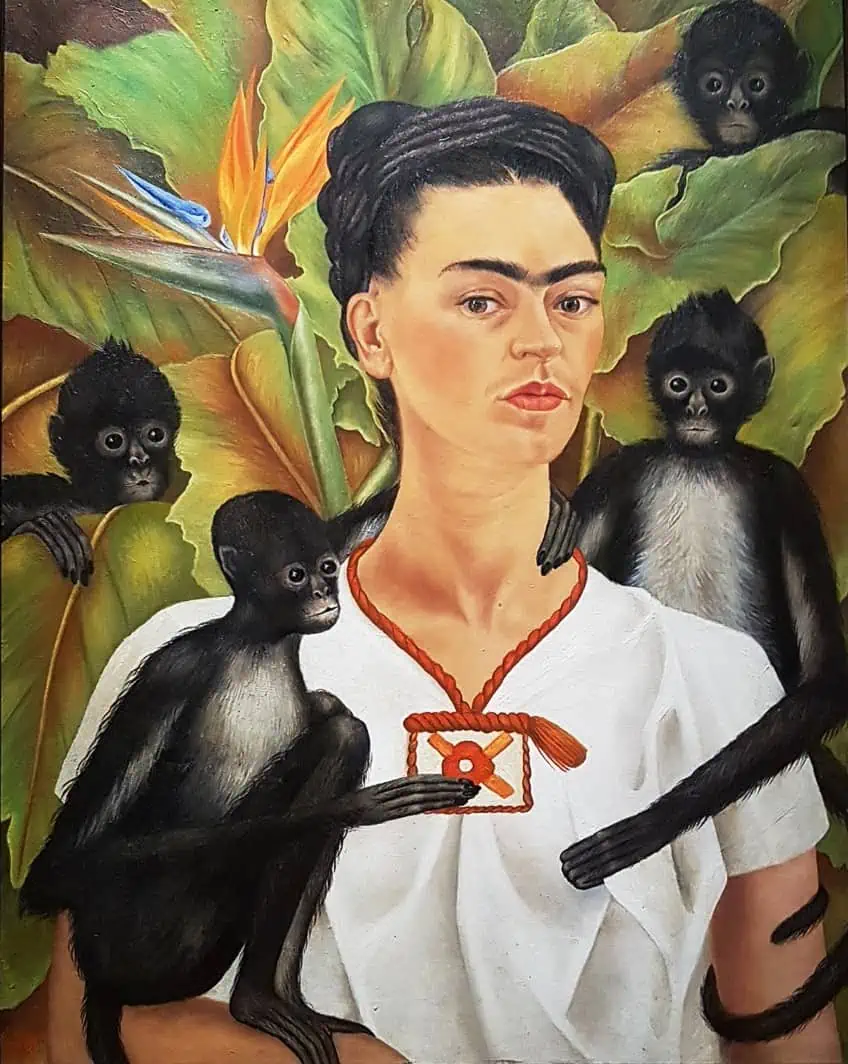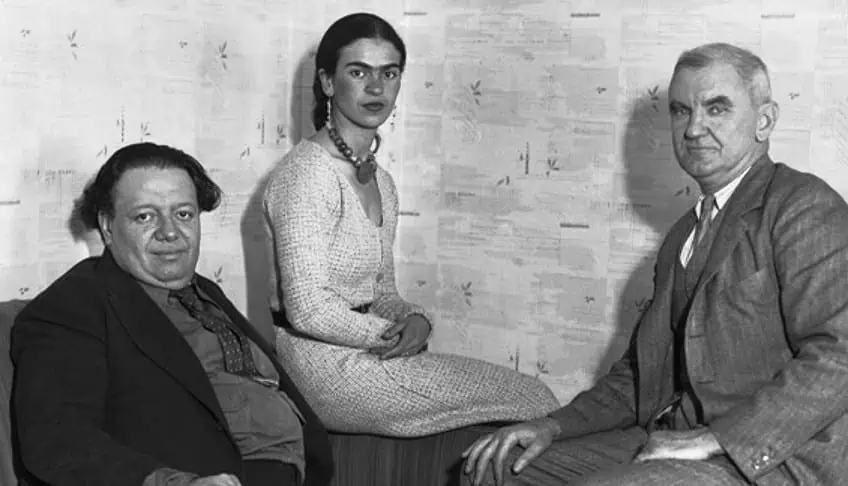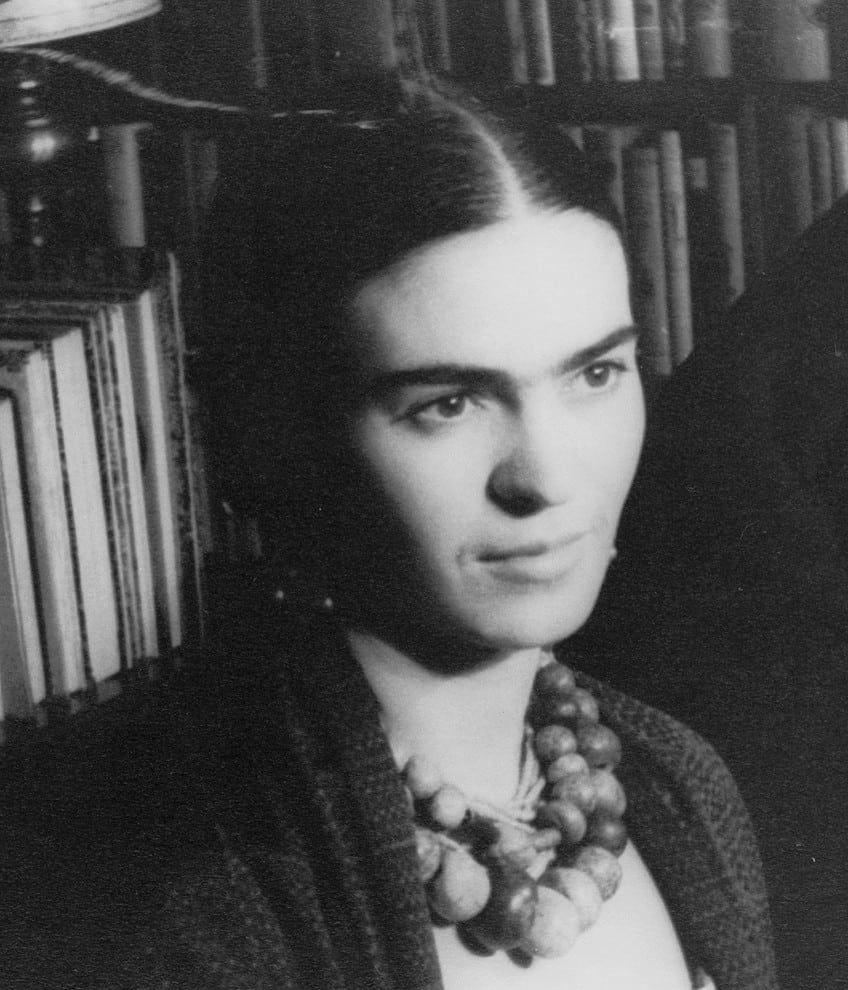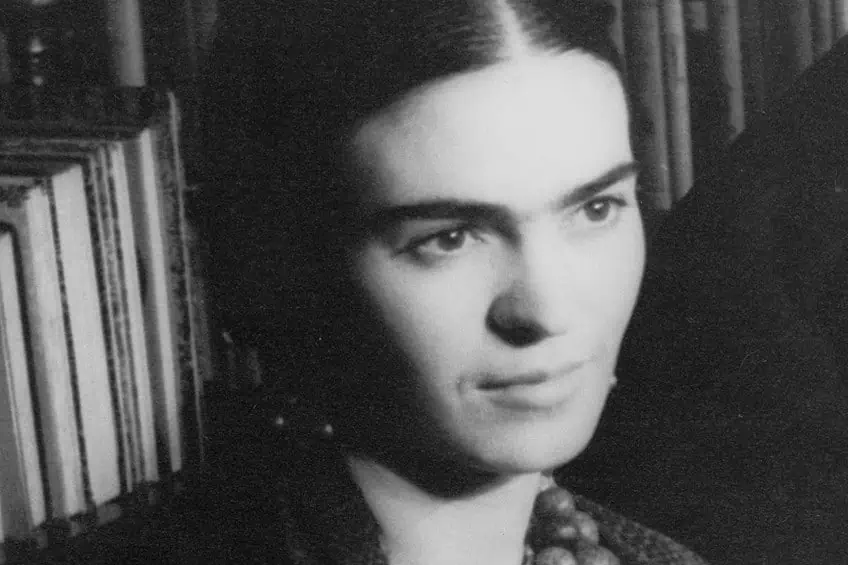“What the Water Gave Me” by Frida Kahlo – Meaning of the Work
What the Water Gave Me by Frida Kahlo is a fascinating painting that shows the artist’s rich imagination and skill to create layered symbolism in her artworks. In this article, we will complete an in-depth visual analysis of What the Water Gave Me painting, in order to understand more about Frida Kahlo as a person and painter.
Artist Abstract: Who Was Frida Kahlo?
Frida Kahlo (1907 – 1954) was a Mexican painter born in 1907. She had a difficult childhood as she suffered from polio at a young age, which left her right leg thinner than her left. Despite her physical challenges, she was a determined and ambitious student, and her love for art began to flourish during her teenage years. She studied at the National Preparatory School in Mexico City, where she met her future husband, the muralist Diego Rivera (1886 – 1957).
Throughout her career, Frida Kahlo’s works were recognized for their intense emotional depth and powerful imagery.

Some of her most famous paintings include The Broken Column (1944), in which she depicted her spine as a broken column to represent her physical pain, and Self-Portrait with Thorn Necklace and Hummingbird (1940), where she depicted herself wearing a necklace of thorns and holding a hummingbird, symbolizing her struggle with love and pain.
What the Water Gave Me by Frida Kahlo in Context
| Date | 1938 |
| Medium | Oil on masonite |
| Type of Painting | Allegory |
| Movement | Surrealism and Symbolism |
| Dimensions (cm) | 91 x 70 |
| Location | Collection of Daniel Filipacchi, Paris, France |
What the Water Gave Me by Frida Kahlo is a powerful and evocative piece that is considered to be one of her most significant works. Created in 1938, this painting reflects the artist’s personal struggles, as well as the socio-political context of Mexico during the time it was created.
What the Water Gave Me by Frida Kahlo in Context of Kahlo’s Life in Mexico
In terms of Kahlo’s personal context, What the Water Gave Me painting is believed to be a reflection of her tumultuous relationship with her husband, the famous Mexican muralist Diego Rivera. The painting depicts a woman, believed to be Kahlo herself, submerged in water, with various objects and symbols floating around her.
The imagery of the water and the objects in the painting can be interpreted as representing the emotional turmoil that Kahlo was experiencing in her relationship with Rivera at the time.

The painting also reflects the socio-political context of Mexico in the 1930s. Mexico was in the midst of a major cultural and political revolution, which was reflected in the art of the time. Kahlo and Rivera were both actively involved in the political and cultural movements of the time and their art reflected this. The painting can be seen as a reflection of the political and social changes that were taking place in Mexico and the world at large.
What the Water Gave Me by Frida Kahlo in Context of Kahlo’s Career
In terms of Kahlo’s career, What the Water Gave Me painting is considered to be one of her most significant works. This painting was created during a time when Kahlo’s work was beginning to gain recognition and acclaim, and it was exhibited in her first solo show in Mexico City in 1940.
This exhibition was a major turning point in her career and helped establish her as an important artist. The painting is also notable for its use of symbolism and surrealism, which were key elements in Kahlo’s art.
The various objects and symbols in the painting, such as the key, the scissors, and the snail, are believed to represent different aspects of Kahlo’s personal life and struggles. The use of surrealism in the painting adds to the sense of emotional turmoil and confusion that is conveyed in the imagery.
What the Water Gave Me Analysis
What the Water Gave Me by Frida Kahlo is a striking and powerful painting that tells a story of both physical and emotional pain, as well as resilience and perseverance. Let us look at the compositional overview, subject matter, light and color use, perspective, and symbolism Frida Kahlo applied in creating this artwork.
Compositional Overview
The painting is composed in a way that immediately draws the viewer’s attention to the central figure of the painting, Frida Kahlo herself. Even though we cannot see Frida’s face or full body, we know from the title of the painting and her deformed right foot that it is the artist’s legs we see in this painting. She is depicted sitting in a shallow bathtub, with only the top of her feet sticking out of the water.
In the still water, a lot of images are reflected – strange symbols out of place in the bathroom scene. From the plughole of the bathtub, a cut artery is dripping blood into the water.
Subject Matter
The subject matter of the painting is deeply personal as it reflects Kahlo’s thoughts and daydreams while she is taking a bath. Her thoughts center around her lovers, her marriage with Diego Rivera, the political work she was involved with for the Communist party of Mexico at the time, her own struggles with chronic pain and disability, and more. She often used her art as a way to express her feelings and experiences, and this painting is no exception. The water in the bathtub is a metaphor for the overwhelming nature of pain, and the various objects that are floating in the water, such as a heart and a snail, symbolize the various physical and emotional struggles that Kahlo faced in her life.
Color and Light
The color palette used in the painting is muted and somber, with shades of blues and greens predominating. However, the bright red of Kahlo’s toenails and the bleeding arteries, as well as the other warm colors included in the surrealistic scene creates strong contrasts which add a layer of drama.
The light in the painting is also dim and subdued, adding to the overall sense of uneasiness and ache. However, there are also moments of brightness and color, such as the red flowers in the background, that suggest hope and resilience in the face of adversity.
The way Kahlo chose to portray the light in the painting adds to the effect of water reflecting the images of her thoughts. The water appears to be like a mirror in some areas, creating a perfect reflection of her feet, and in other areas, it is cloudy and filled with strange elements from her mind. In the cloudy areas, Kahlo’s legs under the water are barely visible.
Texture
The texture in the What the Water Gave Me painting varies. Kahlo makes use of different types of brushstrokes to add to the surreal effect of the scene. The water is rendered in smooth, flat brushstrokes so that the surface of the water does not distract too much from what is “reflected” in it. Other elements of the painting, like the bird and the volcano, are heavily impasto, with thick, layered brushstrokes that give the painting a sense of depth and dimensionality. The roughness of the brushstrokes also adds to the sense of misery and anxiety, as if the viewer is being pulled into the turbulent imagery in the bathtub.
Perspective
The perspective in the painting is highly unusual, with the viewer looking down at Kahlo’s legs as if we are the artist herself. This unusual perspective gives the painting a sense of disorientation and confusion, adding to the sense of overwhelm.
Symbolism: What the Water Gave Me Meaning
What the Water Gave Me by Frida Kahlo is rich in symbolism, with various objects and symbols representing different aspects of her life and experiences. The objects floating in the water, such as a heart, a snail, and a key, symbolize the various physical and emotional struggles that Kahlo faced in her life. The red of her toenails, the bleeding blood vessels, and toes draw our attention to the visceral experience Kahlo had of pain. The color is a representation of vitality and passion, but also pain and death. The skeleton, the choked woman, and the burning building also bring the theme of mortality into the foreground of the painting’s meaning.
In the water, a dead Frida, who looks like Ophelia, is connected to a strange Christ-like figure leaning against the volcano, and some rocks. The rope that connects these symbols carries a progression of strange bugs and figures. This symbolizes the decay that is necessary when things die. And in the context of Kahlo’s life, could also represent her inevitable demise by pain or heartbreak. All these strange symbols bring one predominant question to mind, “what is the point?” It is as if Frida Kahlo is doing a survey of her life in the bathtub, and coming to the conclusion that life is not worth it if it comes with all the pain she has had to bear.
The Critics’ Opinion and the Reception at the First Exhibition
Frida Kahlo’s What the Water Gave Me painting was first exhibited in 1938 at the Julien Levy Gallery in New York City, as part of her first solo exhibition in the United States. The reception of the painting by the public and art critics varied. Some viewers and critics were deeply moved by the emotional intensity and personal nature of the painting, while others found it disturbing and unsettling.
Some art critics praised the painting for its powerful expression of personal pain and suffering. For example, the art critic Edward Alden Jewell (1888 – 1947) wrote in the New York Times that “Frida Kahlo is a painter of exceptional gifts, whose work reveals a highly personal, and at times almost shocking, emotional content.”

He went on to say that What the Water Gave Me was “a powerful and deeply moving painting, the product of a deeply troubled and deeply sensitive mind.” Other critics, however, found the painting upsetting and unnerving. For example, the art critic Clement Greenberg (1909 – 1994) wrote in the New Republic that “Kahlo’s painting is a kind of nightmare, with a disjointed, twisted, and contorted body that seems to express pain and suffering in a way that is almost unbearable to look at.” He went on to say that “Kahlo’s painting is not art, it’s a symptom.”
In conclusion, Frida Kahlo’s What the Water Gave Me painting is a powerful and evocative piece that reflects the artist’s personal struggles, as well as the socio-political context of Mexico during the time it was created. It is considered to be one of her most significant works and it helped establish her as an important artist. The painting’s use of symbolism and surrealism adds to the emotional turmoil and confusion that is conveyed in the imagery, making it a striking and powerful work of art.
Frequently Asked Questions
What Is the Meaning of What the Water Gave Me (1938) by Frida Kahlo?
What the Water Gave Me by Frida Kahlo (1907 – 1954) is a powerful and deeply personal painting that tells the story of Frida Kahlo’s own struggles with chronic pain and disability. The composition, subject matter, color, light, texture, perspective, and symbolism all work together to create a sense of unease, discomfort, and resilience. This painting is a testament to the power of art to express the deepest and most personal feelings and experiences.
How Was What the Water Gave Me (1938) by Frida Kahlo Received by the Public and Critics?
Overall, the reaction to What the Water Gave Me by Frida Kahlo (1907 – 1954) at its first exhibition was mixed. Some critics and viewers found the painting powerful and moving, while others found it disturbing and unsettling. However, it is worth noting that Kahlo’s paintings were not well-known at that time, and the exhibition represented her first solo show in the United States, therefore, it was not a surprise that the reactions were so different from one another.
What Makes Frida Kahlo’s Paintings So Influential?
Frida Kahlo’s (1907 – 1954) paintings, including What the Water Gave Me (1938), have had a significant impact on the history of art, particularly in the realm of feminist art. Her work has inspired numerous feminist artists, who appreciate her ability to convey a sense of self-expression and self-assertion through her art.
Nicolene Burger, a South African multimedia artist and creative consultant, specializes in oil painting and performance art. She earned her BA in Visual Arts from Stellenbosch University in 2017. Nicolene’s artistic journey includes exhibitions in South Korea, participation in the 2019 ICA Live Art Workshop, and solo exhibitions. She is currently pursuing a practice-based master’s degree in theater and performance. Nicolene focuses on fostering sustainable creative practices and offers coaching sessions for fellow artists, emphasizing the profound communicative power of art for healing and connection. Nicolene writes blog posts on art history for artfilemagazine with a focus on famous artists and contemporary art.
Learn more about Nicolene Burger and about us.
Cite this Article
Nicolene, Burger, ““What the Water Gave Me” by Frida Kahlo – Meaning of the Work.” artfilemagazine – Your Online Art Source. March 28, 2023. URL: https://artfilemagazine.com/what-the-water-gave-me-by-frida-kahlo/
Burger, N. (2023, 28 March). “What the Water Gave Me” by Frida Kahlo – Meaning of the Work. artfilemagazine – Your Online Art Source. https://artfilemagazine.com/what-the-water-gave-me-by-frida-kahlo/
Burger, Nicolene. ““What the Water Gave Me” by Frida Kahlo – Meaning of the Work.” artfilemagazine – Your Online Art Source, March 28, 2023. https://artfilemagazine.com/what-the-water-gave-me-by-frida-kahlo/.



